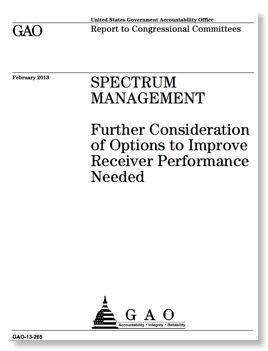GAO Receiver Report
This week GAO released a report entitled “SPECTRUM MANAGEMENT: Further Consideration of Options to Improve Receiver Performance Needed”, shown at left. Your blogger has in the past been impressed with GAO reports on spectrum issues as giving a “breath of fresh air”, this one just covers ground that has been tread on many times.
The report repeats that FCC in general lacks authority to regulate receivers and that NTIA has such authority with respect to federal users. Buried in page 20 of the report is the fact that FCC was able to creatively use its limited power to create a de facto receiver immunity standards in the 800 MHz band to help solve the Nextel/Public Safety problem:
Thus FCC could take similar additional steps in other bands without new legislation.
The report accepts without questioning NTIA’s claimed efficiency at setting receiver standards, but doesn’t ask the question how certain NTIA is about whether federal systems actually meet those standards. Since NTIA does not have an equipment authorization systems, how is compliance verified?
Finally, it gives not mention at all the long standing FCC/NTIA/FAA dispute over receiver immunity standards for Instrument Landing System receivers. While receiver standards are difficult to develop, in the ILS case there is an ICAO Convention standard that FAA will not required for all aircraft in the US because of would offend AOPA, the NRA-equivalent for general aviation. (Here is my fact sheet on this issue.)
The basic reason for this type of problem is that receiver standards are often an economic externality in which the party purchasing the improved receiver gets no tangible benefit. The GAO report does not delve into this issue at all!
The report repeats that FCC in general lacks authority to regulate receivers and that NTIA has such authority with respect to federal users. Buried in page 20 of the report is the fact that FCC was able to creatively use its limited power to create a de facto receiver immunity standards in the 800 MHz band to help solve the Nextel/Public Safety problem:
For example, FCC defined the minimum levels of performance that a receiver must meet to make a claim of harmful interference in the 800 MHz band.
Thus FCC could take similar additional steps in other bands without new legislation.
The report accepts without questioning NTIA’s claimed efficiency at setting receiver standards, but doesn’t ask the question how certain NTIA is about whether federal systems actually meet those standards. Since NTIA does not have an equipment authorization systems, how is compliance verified?
Finally, it gives not mention at all the long standing FCC/NTIA/FAA dispute over receiver immunity standards for Instrument Landing System receivers. While receiver standards are difficult to develop, in the ILS case there is an ICAO Convention standard that FAA will not required for all aircraft in the US because of would offend AOPA, the NRA-equivalent for general aviation. (Here is my fact sheet on this issue.)
The basic reason for this type of problem is that receiver standards are often an economic externality in which the party purchasing the improved receiver gets no tangible benefit. The GAO report does not delve into this issue at all!
0 Comments







![Validate my RSS feed [Valid RSS]](valid-rss-rogers.png)

